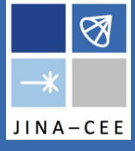Speaker
Dr
Rana Ezzeddine
(MIT)
Description
Elements heavier than hydrogen and helium were first produced in the universe within the
first stars. After a few million years, these presumably massive stars exploded as the first supernovae, ejecting the newly forged elements. Theoretical investigations have long indicated that such supernovae would explode in an asymmetric fashion, but insufficient observational evidence has prevented in-depth studies. Ancient second-generation stars ([Fe/H] < -4.5), forming from gas enriched by the ejecta of the first stars, encodes information about the first stars, such as the explosion mechanism, through the relative abundances of heavy elements like chromium, cobalt, and, most importantly, zinc. In this talk, I will report on the first detection of a Zn line in the UV spectrum of a second-generation star, HE1327-2326, from which [Zn/Fe] = 0.99 was obtained. This confirms that first star progenitors must have undergone aspherical jet-like supernova explosions. I will then discuss the significant implications of such explosions on the chemical enrichment across the early universe.
Primary author
Dr
Rana Ezzeddine
(MIT)
Co-authors
Prof.
Anna Frebel
(Massachusetts Institute of Technology)
Dr
Ian Roederer
(University of Michigan)
